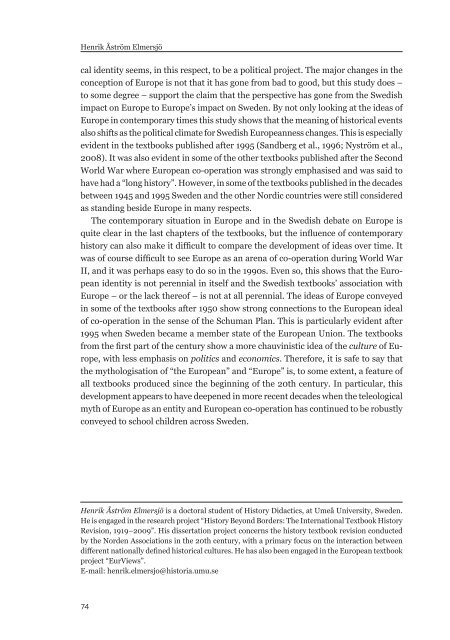Download issue - Umeå universitet
Download issue - Umeå universitet
Download issue - Umeå universitet
Create successful ePaper yourself
Turn your PDF publications into a flip-book with our unique Google optimized e-Paper software.
Henrik Åström Elmersjö<br />
cal identity seems, in this respect, to be a political project. The major changes in the<br />
conception of Europe is not that it has gone from bad to good, but this study does –<br />
to some degree – support the claim that the perspective has gone from the Swedish<br />
impact on Europe to Europe’s impact on Sweden. By not only looking at the ideas of<br />
Europe in contemporary times this study shows that the meaning of historical events<br />
also shifts as the political climate for Swedish Europeanness changes. This is especially<br />
evident in the textbooks published after 1995 (Sandberg et al., 1996; Nyström et al.,<br />
2008). It was also evident in some of the other textbooks published after the Second<br />
World War where European co-operation was strongly emphasised and was said to<br />
have had a “long history”. However, in some of the textbooks published in the decades<br />
between 1945 and 1995 Sweden and the other Nordic countries were still considered<br />
as standing beside Europe in many respects.<br />
The contemporary situation in Europe and in the Swedish debate on Europe is<br />
quite clear in the last chapters of the textbooks, but the influence of contemporary<br />
history can also make it difficult to compare the development of ideas over time. It<br />
was of course difficult to see Europe as an arena of co-operation during World War<br />
II, and it was perhaps easy to do so in the 1990s. Even so, this shows that the European<br />
identity is not perennial in itself and the Swedish textbooks’ association with<br />
Europe – or the lack thereof – is not at all perennial. The ideas of Europe conveyed<br />
in some of the textbooks after 1950 show strong connections to the European ideal<br />
of co-operation in the sense of the Schuman Plan. This is particularly evident after<br />
1995 when Sweden became a member state of the European Union. The textbooks<br />
from the first part of the century show a more chauvinistic idea of the culture of Europe,<br />
with less emphasis on politics and economics. Therefore, it is safe to say that<br />
the mythologisation of “the European” and “Europe” is, to some extent, a feature of<br />
all textbooks produced since the beginning of the 20th century. In particular, this<br />
development appears to have deepened in more recent decades when the teleological<br />
myth of Europe as an entity and European co-operation has continued to be robustly<br />
conveyed to school children across Sweden.<br />
Henrik Åström Elmersjö is a doctoral student of History Didactics, at <strong>Umeå</strong> University, Sweden.<br />
He is engaged in the research project “History Beyond Borders: The International Textbook History<br />
Revision, 1919–2009”. His dissertation project concerns the history textbook revision conducted<br />
by the Norden Associations in the 20th century, with a primary focus on the interaction between<br />
different nationally defined historical cultures. He has also been engaged in the European textbook<br />
project “EurViews”.<br />
E-mail: henrik.elmersjo@historia.umu.se<br />
74

















